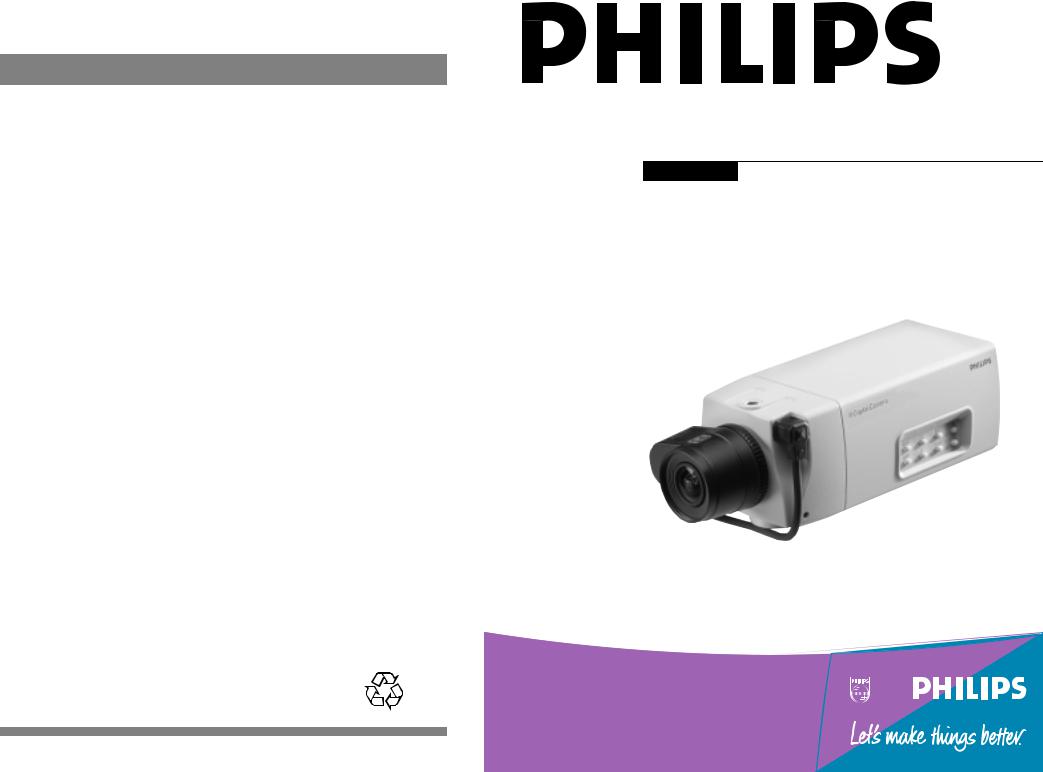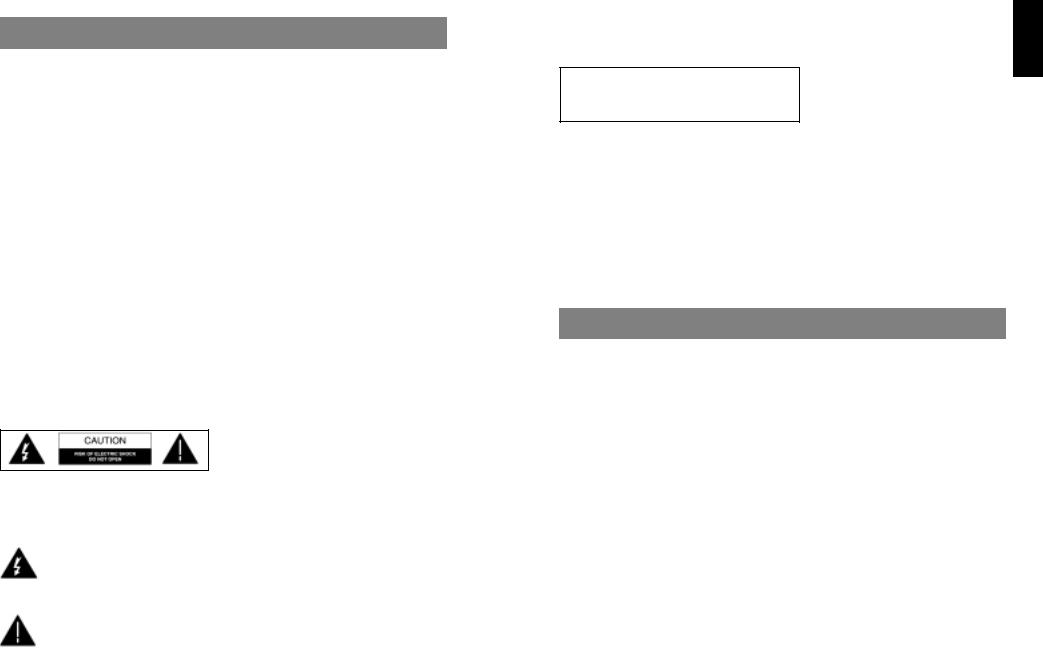Philips LTC0500 User Manual

LTC0500
Digital Black & white Camera
Installation manual
Installationsanleitung
Manuel d’installation
Manuale d’installazione
Installatiehandleiding
Manual de instalación
Subject to changes without notice. © Philips I&C 1999
3122 165 21862

Contents
FCC Statement ________________________________________________ 2
Important Safeguards____________________________________________ 3
1.Introduction ________________________________________________ 6
2.Features ____________________________________________________ 6
3.Preparations ________________________________________________ 7
4.Precautions __________________________________________________ 7
5.Mounting the lens ____________________________________________ 8
5.1Lens adjustments __________________________________________ 9
6.Back focus adjustment ______________________________________ 10
7.Electrical connections ______________________________________ 11
7.1AC Mains Power Supply ____________________________________ 11
7.2 Low voltage AC/DC Input terminal __________________________ 11
7.3Video connections ________________________________________ 12
7.4Synchronisation connection (Sync) ____________________________ 12
7.5Remote control connection (RS-232)__________________________ 12
8.Mounting the camera________________________________________ 13
9.Operating controls and features ______________________________ 13
9.1How to set-up your camera ________________________________ 13
9.2Function set-up __________________________________________ 14
9.2.1Mode setting ________________________________________ 15
9.2.2Video level setting ____________________________________ 15
9.2.3Backlight compensation________________________________ 15
9.2.4Shutter time selection ________________________________ 15
9.2.5Linelock setting ______________________________________ 15
9.2.6Linelock Phase ______________________________________ 15
9.2.7H Phase ____________________________________________16
9.2.8ext V Phase __________________________________________16
10.Specifications ______________________________________________ 16
English
1

FCC Statement
This device complies with Part 15 of the FCC Rules. Operation is subject to the following two conditions:
(1)This device may not cause harmful interference.
(2)This device must accept any interference received including interference that may cause undesired operation.
This equipment has been tested and found to comply with the limits for a Class B digital device, pursuant to Part 15 of the FCC Rules.These limits are designed to provide reasonable protection against harmful interference in a residential installation.
This equipment generates, uses and can radiate radio frequency energy and, if not installed and used in accordance with the instructions, may cause harmful interference to radio communications. However, there is no guarantee that interference will not occur in a particular installation. If this equipment does cause harmful interference to radio or television reception, which can be determined by turning the equipment off and on, the user is encouraged to try to correct the interference by one or more of the following measures:
■Reorient or relocate the receiving antenna.
■Increase the separation between the equipment and receiver.
■Connect the equipment into an outlet on a circuit different from that to which the receiver is connected.
■Consult the dealer or an experienced radio/TV technician for help.
WARNING
YOU ARE CAUTIONED THAT CHANGES OR MODIFICATIONS NOT EXPRESSLY APPROVED BY THE PART RESPONSIBLE FOR THE COMPLIANCE COULD VOID YOUR AUTHORITY TO OPERATE THE EQUIPMENT.
This label may appear on the product.
The lightning flash with an arrowhead symbol, within an equilateral triangle, is intended to alert the user to the presence of uninsulated ‘dangerous voltage’ within the product’s enclosure that may be of sufficient magnitude to constitute a risk of electric shock to persons.
The exclamation point within an equilateral triangle is intended to alert the user to presence of important operating and maintenance (servicing) instructions in the literature accompanying the appliance.
English
WARNING
TO PREVENT FIRE OR SHOCK HAZARD, DO
NOT EXPOSE THIS UNIT TO RAIN OR
MOISTURE.
The Camera series (LTC0500/60 and LTC0600/60) are provided with a correct polarized mains power plug for 120V supply mains.The Camera can accept ‘nominal’ voltage anywhere from 100-240V and can operate on either a 50 or 60Hz system.
If the Camera will be connected to an other mains voltage than 120Vac, use the PROPER mains power connector for that mains voltage.
In case of using a mains voltage of 240V use a correct adapter plug with the following specifications: NEMA plug type 2-15P, 2 pole 2 wire, 15 Amps-250V, or contact qualified Service personnel. See also item Important Safeguards.
Important Safeguards
1)Read Instructions - All the safety and operating instructions should be read before the unit is operated.
2)Retain Instructions - The safety and operating instructions should be retained for future reference.
3)Heed Warnings - All warnings on the unit and in the operating instructions should be adhered to.
4)Follow Instructions - All operating and use instructions should be followed.
5)Cleaning - Unplug the unit from the outlet before cleaning. Do not use liquid cleaners or aerosol cleaners. Use a damp cloth for cleaning.
6)Attachments - Do not use attachments not recommended by the product manufacturer as they may cause hazards.
7)Water and Moisture - Do not use this unit near water - for example, near a bath tub, wash bowl, kitchen sink, or laundry tub, in a wet basement, near a swimming pool, in an unprotected outdoor installation, or any area which is classified as a wet location.
8)Accessories - Do not place this unit on an unstable stand, tripod, bracket, or mount. The unit may fall, causing serious injury to a person and serious damage to the unit. Use only with a stand, tripod, bracket, or mount recommended by the manufacturer, or sold with the product. Any mounting of the unit should follow the manufacturer’s instructions, and should use a mounting accessory recommended by the manufacturer. An appliance and cart combination should be moved with care. Quick stops, excessive force, and uneven surfaces may cause the appliance and cart combination to overturn.
|
|
|
2 |
|
3 |

9)Ventilation - Openings in the enclosure, if any, are provided for ventilation and to ensure reliable operation of the unit and to protect it from overheating.These openings must not be blocked or covered.This unit should not be placed in a built-in installation unless proper ventilation is provided or the manufacturer’ s instructions have been adhered to.
10)Power Sources - This unit should be operated only from the type of power source indicated on the marking label. If you are not sure of the type of power supply you plan to use, consult your appliance dealer or local power company. For units intended to operate from battery power, or other sources, refer to the operating instructions.
11)Grounding or Polarization - This unit may be equipped with a polarized alternatingcurrent line plug (a plug having one blade wider than the other).This plug will fit into the power outlet only one way.This is a safety feature. If you are unable to insert the plug fully into the outlet, try reversing the plug. If the plug should still fail to fit, contact your electrician to replace your obsolete outlet. Do not defeat the safety purpose of the polarized plug. Alternately, this unit may be equipped with a 3-wire grounding-type plug, a plug having a third (grounding) pin.This plug will only fit into a grounding-type power outlet.This is a safety feature. If you are unable to insert the plug into the outlet, contact your electrician to replace your obsolete outlet. Do not defeat the safety purpose of the grounding-type plug.
12)Power-Cord Protection - Power-supply cords should be routed so that they are not likely to be walked on or pinched by items placed upon or against them, paying particular attention to cords and plugs, convenience receptacles, and the point where they exit from the appliance.
13)Power Lines - An outdoor system should not be located in the vicinity of overhead power lines or other electric light or power circuits, or where it can fall into such power lines or circuits. When installing an outdoor system, extreme care should be taken to keep from touching such power lines or circuits as contact with them might be fatal. U.S.A. models only - refer to the National Electrical Code Article 820 regarding installation of CATV systems.
14)Overloading - Do not overload outlets and extension cords as this can result in a risk of fire or electric shock.
15)Object and Liquid Entry - Never push objects of any kind into this unit through openings as they may touch dangerous voltage points or short-out parts that could result in a fire or electric shock. Never spill liquid of any kind on the unit.
16)Servicing - Do not attempt to service this unit yourself as opening or removing covers may expose you to dangerous voltage or other hazards. Refer all servicing to qualified service personnel.
17)Damage Requiring Service - Unplug the unit from the outlet and refer servicing to qualified service personnel under the following conditions
a)When the power-supply cord or plug is damaged.
b)If liquid has been spilled, or objects have fallen into the unit.
c)If the unit has been exposed to rain or water.
English
d)If the unit does not operate normally by following the operating instructions. Adjust only those controls that are covered by the operating instructions, as an improper adjustment of other controls may result in damage and will often require extensive work by a qualified technician to restore the unit to its normal operation.
e)If the unit has been dropped or the cabinet has been damaged.
f)When the unit exhibits a distinct change in performance this indicates a need for service.
18)Replacement Parts - When replacement parts are required, be sure the service technician has used replacement parts specified by the manufacturer or have the same characteristics as the original part. Unauthorized substitutions may result in fire, electric shock or other hazards.
19)Safety Check - Upon completion of any service or repairs to this unit, ask the service technician to perform safety checks to determine that the unit is in proper operating condition.
20)Coax Grounding - If an outside cable system is connected to the unit, be sure the cable system is grounded. U.S.A. models only—Section 810 of the National Electrical Code,ANSI/NFPA No.70-1981, provides information with respect to proper grounding of the mount and supporting structure, grounding of the coax to a discharge unit, size of grounding conductors, location of discharge unit, connection to grounding electrodes, and requirements for the grounding electrode.
21)Lightning - For added protection of this unit during a lightning storm, or when it is left unattended and unused for long periods of time, unplug it from the wall outlet and disconnect the cable system.This will prevent damage to the unit due to lightning and power-line surges.
NOTE
•For permanently connected equipment, a readily accessible disconnect device shall be incorporated in the fixed wiring;
•For pluggable equipment, the socket-outlet shall be installed near the equipment and shall be easily accessible.
|
|
|
4 |
|
5 |
